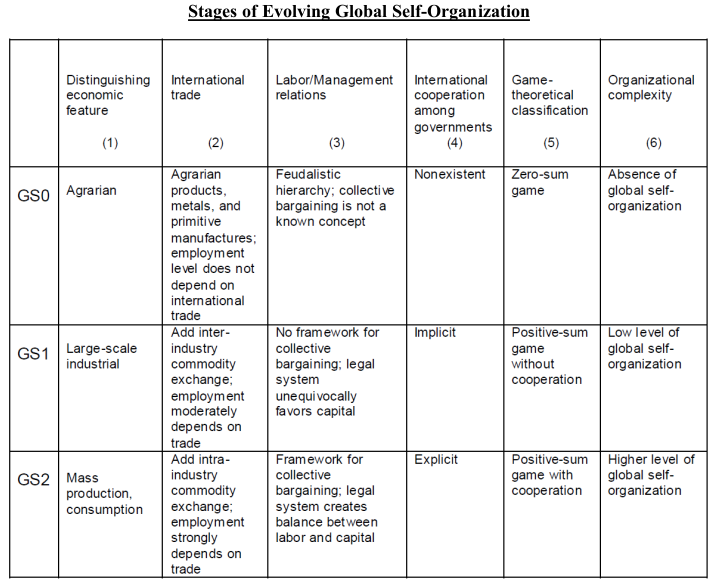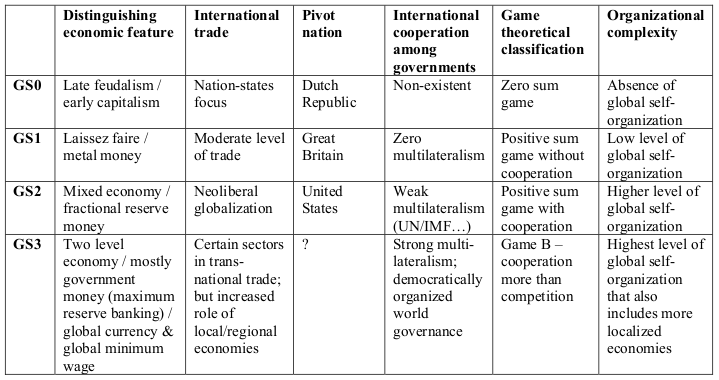Stages of Evolving Global Self-Organization
= the evolution of the global system according to Peter Pogany
Description
Background to the tables, provided by Dave MacLeod:
"Peter Pogany (1936-2014) was born in Budapest, Hungary. As a trained Economist, he taught International Economics in Vietnam, worked as a Senior Economist and Statistician for Petroci in the Ivory Coast in Africa; worked as an Economist for the U.S. International Trade Commission (where he contributed to many high-profile U.S. government studies on foreign economic issues), and was an Adjunct Professor at George Washington University.
Pogany framed the stages of recent world history as Global System 0 (GS0), Global System 1 (GS1), Global System 2 (GS2), and Global System 3 (GS3). Each of these can be considered sub-epochs within modernity. Pogany saw each of these sub-epochs as self-organizing systems where the people embedded in them are so enmeshed socially, culturally, spiritually, economically, that it becomes their 'myth of the given.' They can't see other ways of being or organizing and the system itself reinforces what contributes to the system and squeezes out opposing forces and ideas. Therefore it's very difficult to change the system. Pogany’s views were in line with those of cultural philosopher Jean Gebser, who argued that system change only happens when the existing system goes into decay, and through a chaotic transition the next oncoming system "overdetermines" the previous system.
A kind of progression or cultural evolution can be observed through these different stages, gradually becoming more like an evolved, mature, dynamic ecosystem where dominator species do not thrive, and collaborative species thrive more and more. However, it is not a gradual progression. Pogany framed it as a series of abrupt bifurcations, along the lines Gebser outlined, and consistent with the disequilibrium thermodynamics of Ilya Prigogine.
“As elaborated by Ilya Prigogine, the father of modern disequilibrium thermodynamics, a material entity that gains in size while becoming increasingly complex (where complexification is defined as growing volumes of information generated and transmitted among the entity’s decision centers) must undergo an alternation between relative (dynamic) steady states and bifurcations (chaotic transitions).” - Peter Pogany, “ ‘Fifth Structure’ – emergence in economics: Observations through the thermodynamic lens of world history” (2009, p. 4).
The heart of the document, World History as the Synoptic Narrative of Thermodynamic Unfolding, with the chart above came originally as part of a 2010 paper called “What’s Wrong with the World? Rationality! A critique of economic an....” It was later published as Appendix B in the book “Havoc: Thy Name is Twenty First Century,” (2015). This paper (link below) is based mostly on the last edit printed in “Havoc,” with some additions that come from the original 2010 paper…and various additional quotes at the end." (https://st6.ning.com/topology/rest/1.0/file/get/4565377457?profile=original)
Discussion
Details on GS3
The potential third global system that Pogany projected as a possibility (outlined in the 2nd table above) was thus characterized:
"Long-term world equilibrium -- GS3
The thermodynamic interpretation of global history predicts a halt to population and economic expansion for purely physical reasons. This general condition requires a new global system: GS3 – two-level economy/strong multilateralism/mostly government money (maximum reserve banking).
Legally binding international agreements on the use of nonrenewable energy and material resources, as well as on harmful emissions, would enlarge the government’s role in economic affairs since administrative methods would be needed to ensure national compliance with globally determined goals. The implied strong multilateralism would split national economies (hence, the world economy) into a free-market and a public authority-dominated sector. While carrying on the best traditions of constructive entrepreneurship, businesses in the first domain would bid for resources and emission rights; joint private-public ownership would prevail in the second one. The state’s substantial holding of private shares would eliminate most, if not all, income taxation.
The monetary system would be based on a global currency issued by the global central bank. The world currency would combine the discipline GS1’s gold standard vouchsafed and the flexibility GS2’s fiat money has provided (without the fractional reserve system, which, as will become obvious during the first half of the 21st century, is wholly incompatible with any consciously pursued economic steady state.) Much along the lines proposed by Keynes at the 1944 Bretton Woods conference, an international clearing house would keep cross-border trade in equilibrium.
Maximum bank reserves would restrict the ability of banks to extend loans. Just as under the prevailing minimum reserve system, some banks in some instances may keep no reserves at all; under the maximum reserve system some banks in some instances might be required to keep 100 percent reserves. While such an arrangement may not eliminate the creation of money through debt, it would certainly change its nature. The consent of depositors would be required to make loans, making financial intermediation once again the modest helper that draws together scattered household savings in order to place them into the hands of bona fide entrepreneurs. “Enterprise,” in the Keynesian sense, would squeeze out “speculation.” The economic role of grass roots communities would increase significantly." (via fb, via Dave MacLeod, July 2020)
Visualizations
1
Source: Stages of Evolving Global Self-Organization, from "What’s wrong with the world? Rationality! A critique of economic anthropology in the spirit of Jean Gebser" by Peter Pogany. Shenandoah Valley Research Press, 5. November 2010
2
Source: David MacLeod added another stage, GS3, to Peter Pogany's table.

